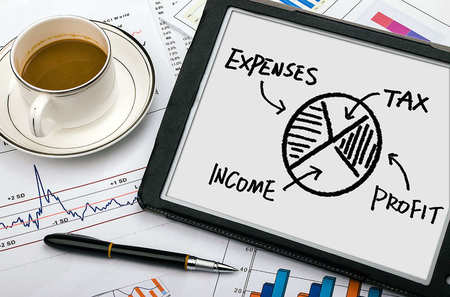
Just because there’s a positive balance in your checking account doesn’t mean that your business is making money. Checks that you’ve written for expenses may not have cleared yet, or customers could have paid in advance. Relying on a positive balance to determine if your business is solvent could be dangerous.
Cashflow represents the movement of cash in and out of your business. Cashflow management seeks to match the inflows and outflows so that you’re never short-handed, though sometimes business owners must borrow to cover gaps.
Learning more about the ups and downs of how cash flows in and out of your business will help you make better strategic and borrowing decisions. The past can inform the future when forecasting cashflow. But before you get into analyzing a cashflow statement, you must understand it.
Sections of the Cashflow Statement
The cashflow statement is divided into three sections, each of which tells you something different about your business’ health. While your accountant may prepare the statement for your business, you should still learn what each section signifies.
Cashflow from Operations
The top section presents the net cash flows from operations. It lays out the cash in from customers and out for expenses. Consistently negative cashflow from operations means that your business’s activities aren’t generating enough money to cover its expenses. While you may still show a positive balance in your checking account other activity could be keeping your business afloat.
The cashflow from operations contains several items would you should carefully examine. The first, accounts receivable, tells you how much money you’re owed. If this balance keeps growing every month your business has a problem collecting monies owed.
It’s important to act quickly on any possible issues in accounts receivable before the balance grows so high it harms your ability to stay in operations. Digging deeper into accounts receivable, such as with an aging report could reveal customers who consistently pay late. The bucket of more than 120 days past due should be your target for collections activities. You should also consider if a customer costs you more time and money than they’re worth.
Inventory balances could tell you if you’re running on low or lean inventory which could harm your future sales. A high inventory balance but low cash-on-hand indicates that you likely just paid to acquire significant new stock. Seasonal businesses should definitely become aware of these cash-poor, inventory-rich cycles so that they’re ready to borrow working capital if needed.
Accounts payable holds the balance of what you owe vendors and suppliers. Typically, it should be closely tied to accounts receivable. This is because what you pay others for inventory, overhead, or services, should generate revenue.
Cashflow from Investing Activities
In a simple small business, this section could contain just a few lines. The profit and loss from the sale of fixed assets would appear here. If you sold a fixed asset, such as an oven, and saw a net amount of cash deposited into your bank account, you may have thought you made a profit. This isn’t always the case.
Depreciation and the initial price paid could mean that the sale is a net loss on the books. Understanding this concept will help you make wise acquisition and divestiture decisions.
Cashflow from Financing Activities
This section represents your business’s third-party cash generation. Here you’ll find short and long-term loan balances as well as balances on revolving lines of credit. While the Balance Sheet shows you a point in time balance of debt, and the Income Statement tells you how much interest you’re paying, the Cashflow Statement discloses if you’re paying down debt or borrowing more over time.
Increasing loan and debt balances with shrinking revenues and cash from operations indicates that debt could be propping up your business. You should take immediate action to trim expenses and increase revenues.
Important Ratios from the Cashflow Statement
In addition to understanding what each section represents and the story it tells you about your business, you can also calculate ratios from the cashflow statement, which contribute to your understanding.
Current Liability Coverage Ratio
A more short-term focused ratio, it measures if you can generate cash to cover debts due within a year. To calculate the ratio, take your net cash from operating activities and divide it by your average current liabilities from your average Balance Sheet. You’re looking for a ratio of 1.5 and above.
Lower ratios are a warning sign that you could struggle to pay your current liabilities from your net cashflow.
Free Cashflow
How much money do you have left over after paying your bills? Your free cashflow ratio answers this question. Subtract capital expenditures from your net operating cashflow to find out.
Cashflow Coverage Ratio
If you’ve grown concerned about your business’ ability to make payments on its long-term debt, this ratio will tell you if your concern is justified. The cashflow coverage ratio divides cashflow from operations by total debt.
This ratio measures if you could pay off all your debt from cashflow from operations if the lender called it due. A ratio greater than one is preferred, and the higher, the better.
Tips on Analyzing a Cashflow Statement
Decide which ratios and metrics matter to your business and create an established procedure for analysis. Perhaps it’s a monthly meeting with your accountant or other stakeholders. Smaller companies could save the cashflow statement for a quarterly review, whereas larger businesses often monitor it monthly.
Comparing the same metrics over time paints a picture of your business’ activity, so you should always track and compare the same metrics. Talk to your accountant to decide what’s relevant to your business. Monitoring inventory would be useless for a service-based business, for example, but extremely important to a manufacturer.
Over time, as you gain experience analyzing your cashflow statement you’ll also be able to interpret it faster. Then you can pivot and make important business decisions to balance cashflow and keep your company running smoothly.
